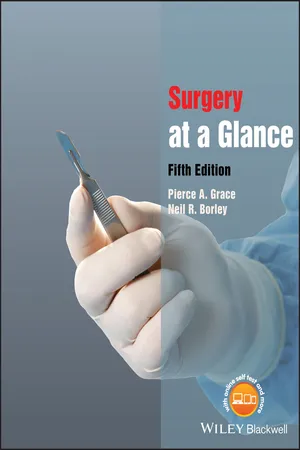
- English
- ePUB (mobile friendly)
- Available on iOS & Android
Surgery at a Glance
About This Book
This new edition of Surgery at a Glance provides a concise and visually-orientated summary of a comprehensive lecture course in surgery. Following the easy-to-use at a Glance format, each topic is presented with clear illustrations and key facts encapsulating all that you need to know.
The book is coherently divided into clinical presentations followed by major surgical conditions. Exploring core principals and important diseases, it is an accessible companion to any surgery core text, and is ideally placed to support the current curriculum.
Surgery at a Glance:
•Features brand new chapters on Orthopaedics and updates on the management of surgical conditions
•Includes more revision-friendly elements for quick reference
•Is fully supported by a resource website at www.testgeneralsurgery.com containing both MCQs and short answer questions
Frequently asked questions
Information

Definition
- Thyroid swellings move upwards (with the trachea) on swallowing.
- Most abnormalities of the neck are visible as swellings.
- Ventral lumps attached to the hyoid bone, such as thyroglossal cysts, move upwards with both swallowing and protrusion of the tongue.
- Multiple lumps are almost always lymph nodes.
- In all cases of lymphadenopathy a full head and neck examination, including the oral cavity is mandatory.
Differential Diagnosis
- 50% of neck lumps are thyroid in origin.
- 40% of neck lumps are caused by malignancy (80% metastatic usually from primary lesion above the clavicle; 20% primary neoplasms: lymphomas, salivary gland tumours).
- 10% of neck lumps are inflammatory or congenital in origin.
Thyroid
- Goitre, cyst, neoplasm.
Neoplasm
- Metastatic carcinoma.
- Primary lymphoma.
- Salivary gland tumour.
- Sternocleidomastoid tumour.
- Carotid body tumour (rare).
Inflammatory
- Acute infective adenopathy.
- Collar stud abscess.
- Parotitis.
Congenital
- Thyroglossal duct cyst.
- Dermoid cyst.
- Torticollis.
- Branchial cyst.
- Cystic hygroma.
Vascular
- Subclavian or brachiocephalic ectasia (common).
- Subclavian aneurysm (rare).
Important Diagnostic Features
Children
- Congenital and inflammatory lesions are common.
- Cystic hygroma: in infants, base of the neck, brilliant transillumination, ‘come and go’.
- Thyroglossal or dermoid cyst: midline, discrete, elevates with tongue protrusion.
- Torticollis: rock hard mass, more prominent with head flexed, associated with fixed rotation (a fibrous mass in the sternocleidomastoid muscle).
- Branchial cyst (also fistulae or sinus): anterior to the upper third of the sternocleidomastoid.
- Viral/bacterial adenitis: usually affects jugular nodes, multiple, tender masses.
- Neoplasms are unusual in children (lymphoma most common).
Young Adults
- Viral (e.g. infectious mononucleosis) or bacterial (tonsillitis/pharyngitis) adenitis.
- Papillary thyroid cancer: isolated, non-tender, thyroid mass, possible lymphadenopathy.
Over-40s
- Metastatic lymphadenopathy: multiple, rock hard, non-tender, tendency to be fixed.
- 75% in primary head and neck (thyroid, nasopharynx, tonsils, larynx, pharynx), 25% from infraclavicular primary (stomach, pancreas, lung).
- Primary lymphadenopathy (thyroid, lymphoma): fleshy, matted, rubbery, large size.
- Primary neoplasm (thyroid, salivary tumour): firm, non-tender, fixed to tissue of origin.
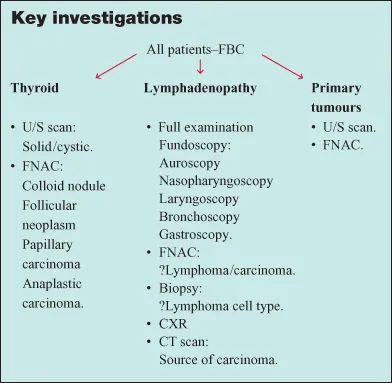
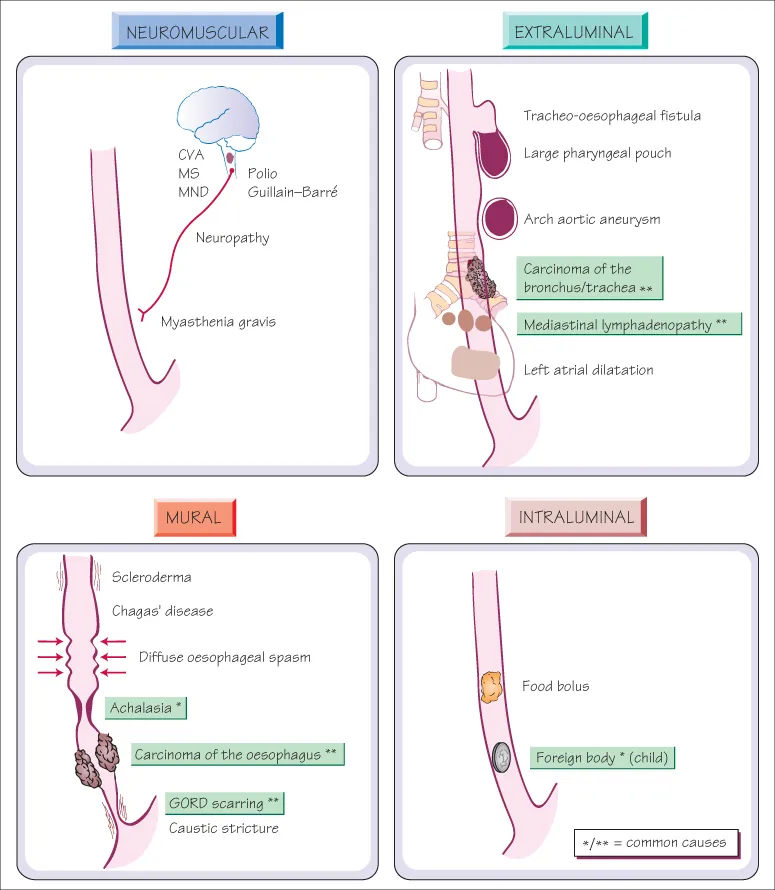
Definition
- Most causes of dysphagia are oesophageal in origin.
- In children, foreign bodies and corrosive liquids are common causes.
- In young adults, reflux stricture and achalasia are common.
- In the middle aged and elderly, carcinoma and reflux are common.
- Because the segmental nerve supply of the oesophagus corresponds to the intercostal dermatomes, a patient with dysphagia can accurately pinpoint the level of obstruction.
- Any new symptoms of progressive dysphagia should be assumed to be malignant until proven otherwise. All need endoscopic ± radiological investigation.
- Tumour and achalasia may mimic each other. Endoscopy and biopsy are advisable unless the diagnosis is clear.
Important Diagnostic Features
Mural Causes
- Carcinoma of the oesophagus: progressive course, associated weight loss and anorexia, low-grade anaemia, possible small haematemesis.
- Reflux oesophagitis and stricture: preceded by heartburn, progressive course, nocturnal regurgitation (24-hour oesophageal pH monitoring may be indicated).
- Achalasia: onset in young adulthood or old age, liquids disproportionately difficult to swallow, frequent regurgitation, recurrent chest infections, long history.
- Tracheo-oesophageal fistula: recurrent chest infections, coughing after drinking. Present in infants (congenital) or late adulthood (post trauma, deep X-ray therapy (DXT) or malignant).
- Chagas’ disease (Trypanosoma cruzi): South American prevalence, associated with dysrhythmias and colonic dysmotility.
- Caustic stricture: examination shows corrosive ingestion, chronic dysphagia, onset may be months after ingestion of caustic agent. Long term risk of developing SCC (1–4%).
- Scleroderma: slow onset, associated with skin changes, Raynaud’s phenomenon and mild arthritis.
Intraluminal Causes
Extramural Causes
- Pulsion diverticulum (proximal: pharyngo-oesophageal [Zenker’s]; distal: epiphrenic): intermittent symptoms, unexpected regurgitation, halitosis.
- External compression: mediastinal lymph nodes, left atrial hypertrophy, bronchial malignancy.
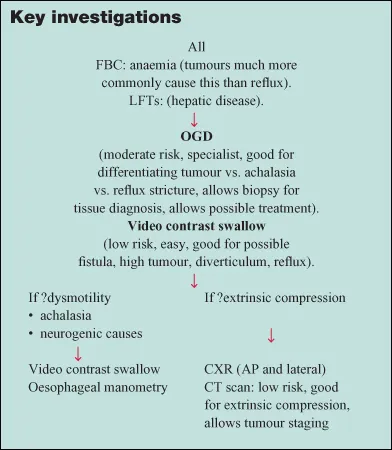
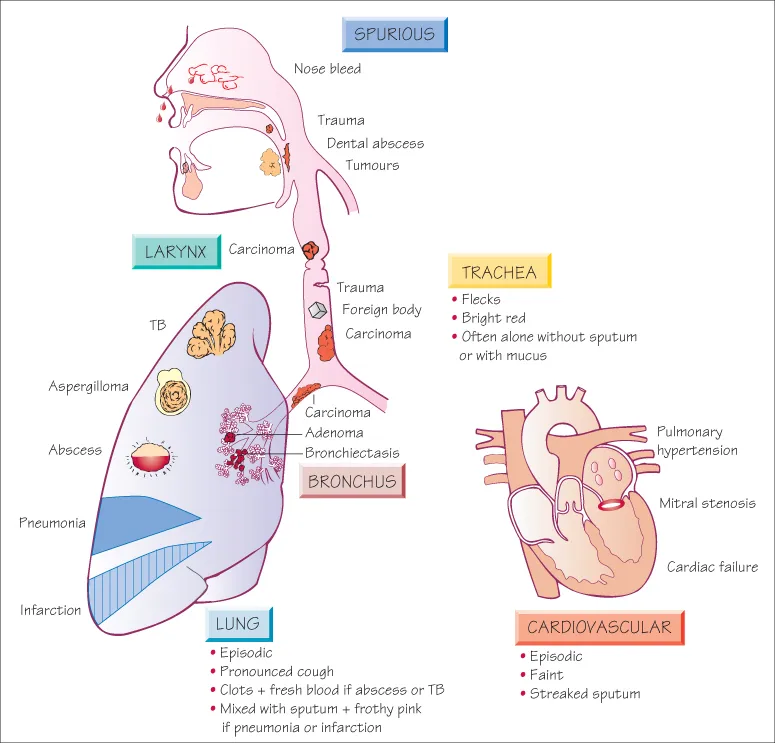
Definition
- Blood from the proximal bronchi or trachea is usually bright red. It may be frank blood or mixed with mucus and debris, particularly from a tumour.
- Blood from the distal bronchioles and alveoli is often pink and mixed with frothy sputum (e.g. pulmonary oedema).
Important Diagnostic Features
Spurious Haemoptysis
Mouth and Nose
- Blood dyscrasias: associated nose bleeds, spontaneous bruising.
- Scurvy (vitamin C deficiency): poor hair/teeth, skin bruising.
- Dental caries, trauma, gingivitis.
- Oral tumours: painful intraoral mass, discharge, fetor.
- Hypertensive/spontaneous: no warning, brief bleed, oft...
Table of contents
- Cover
- Companion website
- Title page
- Copyright page
- Preface
- List of abbreviations
- Part 1: Clinical presentations at a glance
- Part 2: Surgical diseases at a glance
- Index